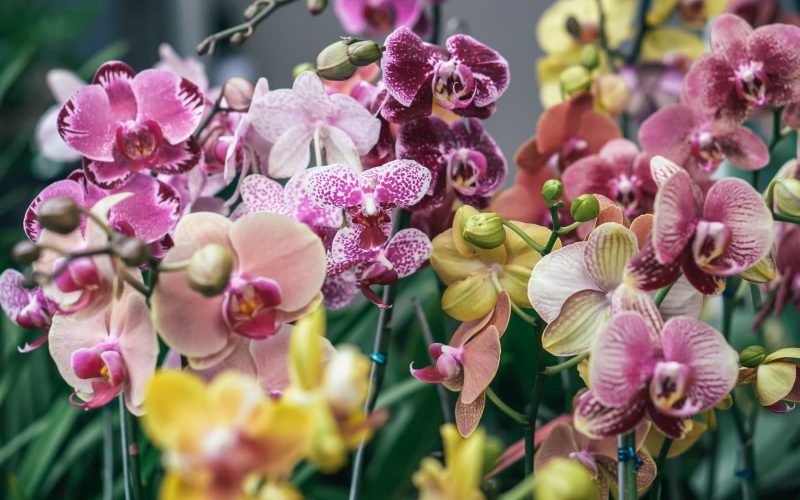Of course, growing orchids for their flowers is a great way to enjoy them. But are orchids edible? Some orchid flowers are edible, but there’s no easy way to tell which ones are.
Before you try munching on an orchid blossom from your garden, it’s s important to know that while certain varieties have edible flowers, they also have toxins that can make you sick (or worse).
Many people eat dandelion because of their toxic nature. So before you venture out into your yard with a dandelion salad, consider getting educated about which species are safe and which aren’t.
Are orchids edible? Here are orchids you didn’t know were edible. Or not—some might be poisonous, so be sure to do your research before eating anything from your yard.
Enjoy their beauty as part of your landscaping if you can’t eat them!
List of Orchids Edible
1. Cattleya
Cattleyas are often considered one of the most widely cultivated orchids because they come in many colors, shapes, and sizes.
They’re also known for being relatively easy to grow, so many people have them around their homes as decorative plants.
If you’ve got a Cattleya but aren’t using it for its edible properties, you’re missing out on an excellent food source.
The petals can be eaten raw or cooked, making a perfect ingredient for salads or snacks. They taste similar to banana peppers with a bit of citrus.
So, are orchids edible? The answer is cattleya is edible. Meanwhile, ensure it’s not poisonous before eating any part of your orchid! Wide common varieties (such as phalaenopsis) are toxic if ingested!
2. Epidendrum
The Epidendrum orchid might not be as well-known as some of its cousins regarding ornamental plants. Also known as a slipper orchid, you can make an unusual pet from your plant due to its unique shape.
The Epidendrum proliferates and is relatively easy to grow in most soil and light conditions. Let it root wherever it touches the soil, cut off any new growth inside the flower’s mouth, and enjoy your edible ornament. But the great question is, are orchids edible? This particular orchid is edible.
3. Encyclia
This genus includes over 160 species and is also known as buttonhole orchids due to their distinctive shape. The Encyclia’s flower buds are wrapped in a tissue layer resembling a buttonhole, making them stand out from other orchid types.
Typically, these flowers reach between 4 and 6 inches in size and bloom year-round, with colors ranging from pink to yellow and lavender. Some species are also often used for medicinal purposes.
4. Laelia
These petite blooms are not to be overlooked. They’re often used as accents in flower arrangements, but their flavor makes them a tasty treat all on their own.
Often served chilled and set atop cucumber slices, their subtle sweetness is an absolute delight, especially for those who have never had them before.
If you’re looking for a new way to experience your favorite flower, try a lovely chilled Laelia orchid with cucumber slices as soon as possible!
5. Miltonia
Try a Miltonia plant if you’re looking for a new, exotic plant to grow indoors. With their beautifully colored flowers, these rare orchids will add some elegance to your home.
Moreover, they answer your question, “Are orchids edible?” These particular ones are edible, too! Miltonia flowers are famous delicacies in many tropical countries, such as Brazil and Malaysia.
Meanwhile, to harvest them at home for dinner, cut off one of its petals just below its attachment point to the stem and gently pull it away from the rest of the flower. Use a pair of kitchen shears if you don’t want to risk damaging your delicate petals.
6. Oncidium
These orchids come in various colors and often have lovely flowers resembling butterflies. Because they are available year-round, they are a great addition to tropical dishes. They make flavorful additions to curries, stews, and vegetable dishes.
When you buy orchids from your local flower shop, choose healthy-looking ones with exemplary coloration. Wash them thoroughly before you use them in recipes to remove any pesticides or residue on their skin. We are committed to answering your question,” Are orchids edible?” Oncidium is edible.
7. Paphiopedilum
This pretty flower, known as The Singing Lady and Lady of China, is relatively easy to grow in a greenhouse. The Paphiopedilum typically grows on trees in tropical forests.
So, if you have a green thumb, why not plant one of these beauties outside? Remember to harvest before it comes into bloom—eating an orchid in a flower could be poisonous.
One word of caution: Never eat any orchid protected by thorns! The Paphiopedilum tastes like cucumber with a hint of cinnamon and peppermint when eaten raw.
8. Phalaenopsis
This species of orchid isn’t just edible; it’s delicious. In Thailand, it is a culinary and medicinal plant called rain kanun.
Although most cooks consider orchids an ornamental plant, they are sweet and have a unique flower flavor. They can be added to soups, stir-fries, and curries. They also make for a tasty drink called orchid tea.
9. Pleione
This herbaceous perennial, native to Europe and Asia, has long been grown as an ornamental. During World War II, it gained a second life as one of three ingredients used in a popular tea enjoyed by many British civilians and members of Churchill’s cabinet.
Also, the Pleione is suitable for making stews and other mixed dishes; it’s often called poor man’s asparagus. (Though not related to orchids proper, its family members are known colloquially as orchid sprouts.)
Its leaves are best harvested before they flower; like dandelion greens, they lose flavor afterward. Pick them while they’re young, and enjoy their earthy taste with a splash of lemon juice.
10. Renanthera
This evergreen orchid, native to Southeast Asia, is known by many names, including Malaysian and butterfly orchids.
The Renanthera has a solid flowery smell (often compared to anise) that some people find unpleasant. But don’t let it deter you from picking and enjoying them.
The taste of Rennantheras varies depending on their age; leaves picked from older plants have a mild flavor that resembles lettuce.
Younger leaves have a more intense flavor that might remind you of sage. Be sure to harvest only parts of your plant—leaves can take up to a year to grow. So, try not to pick all its flowers at once; too much picking at once can weaken your plant’s overall health.
11. Dried Orchid Tuber
We’re talking about orchid tubers, as in those spongy-looking things at the roots of your pot of flowers. The tubers are edible and have a chewy texture similar to chestnuts.
Enjoy them like you would eat radishes or artichokes; raw, roasted, or boiled is fine. They have a sweet-and-sour taste reminiscent of Jerusalem artichokes with more herbal undertones.
The plant most people know is vanilla, but many others are out there—some tasty, some poisonous. Your typical question, “Are orchids edible?” has been thoroughly addressed.








